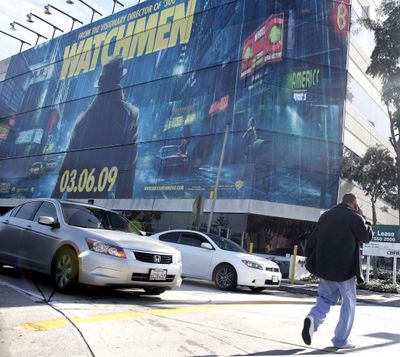Billboard backlash
Outcry prompts Los Angeles to rethink billboard regulations

LOS ANGELES – David Allan works in advertising – literally. The six-story building where the chiropractor works is draped in it.
“It’s awful, it’s ridiculous,” he said of the massive vinyl banner promoting TV shrink Dr. Phil McGraw that obscures his view of the scenic Santa Monica Mountains.
Such supergraphics and digital signs are among the new generation of public ads infuriating critics across the country who say the “billboard blight” distracts drivers, hurts the look of streets and could hinder access by rescue crews.
Kevin Fry, president of the Washington-based anti-billboard group Scenic America, said Los Angeles has the worst billboard problem in the country.
The proliferation has prompted officials to impose a moratorium on new ads as the city considers new regulations aimed at reducing the number of billboards, limiting their size and increasing penalties against those who flout the rules. Past efforts largely collapsed after court challenges by the billboard industry.
The new regulations would also ban digital billboards in most parts of the city. The Planning Commission is scheduled to consider the rules on Thursday.
Meanwhile, misdemeanor charges have been filed against firms suspected of violating the city moratorium on new supergraphic and digital billboards.
“The billboard industry in the city is clearly out of control,” said Planning Commission member Mike Woo, who teaches urban planning at the University of Southern California.
“It’s like junk mail or junk phone calls, except this is changing the public environment in very visible ways,” he said.
Advertisers counter that new billboard technologies help businesses reach consumers in an age when TiVo users can skip through commercials and newspaper ads are reaching fewer readers.
They insist that safety fears are exaggerated and stress that courts have repeatedly sided with their right to advertise.
“As far as any kind of health and safety issues are concerned, that’s a ruse by the city” to circumvent the court rulings, said Barry Rush, managing partner of World Wide Rush LLC, the firm behind the Dr. Phil ad.
“The last thing I’d ever want to do is endanger somebody,” he said.
Advertisers can pay more than $8,000 for a standard billboard on a busy Los Angeles thoroughfare, compared to $110,000 for a prominent supergraphic, said Megan Weiss, a strategist with The Phelps Group marketing agency.
The spread of billboards also has sparked increasingly vocal opposition in cities such as Cleveland, San Antonio and Omaha, Neb. Community groups in New York also are objecting as outdoor ads spread deeper into Manhattan from Times Square.
In Los Angeles, opponents point to a four-story office building in West Los Angeles draped with an ad for the film “Watchmen” and a provocative series of ads for American Apparel in residential Echo Park as some of the most disruptive billboards.
They note that enforcement has traditionally been lax and attitudes toward ads have been permissive in the city where the Hollywood sign was erected decades ago as a way to promote a housing tract.
The most recent round of billboard opposition crystalized two years ago when major outdoor advertising companies reached a series of court settlements with the city that activists viewed as a giveaway to the billboard industry.
CBS Outdoor, Clear Channel Communications Inc. and Regency Outdoor Advertising Inc. agreed to drop a lawsuit challenging the fairness of a 2002 ban on billboards in most parts of the city in exchange for a sharp drop in their permit fees and the right to digitize nearly 900 billboards.
That led to the recent spate of digital billboards, which have sparked traffic safety concerns among officials as well as grousing by residents that light from the signs could be seen through their windows.
“You can’t get away from it: it’s always there and it’s always on,” said Susan Greenberg, 68, whose bedroom window provides a clear view of a digital billboard across the street.
Last week, the City Council voted to endorse a proposed two-year state moratorium on electronic billboards while a federal study determines whether the signs are dangerous distractions for drivers.
Meanwhile, city prosecutors are investigating supergraphic signs that allegedly went up in violation of the moratorium, Chief Assistant City Attorney David Michaelson said.
More than 20 criminal charges have been filed against World Wide Rush, one of the city’s most active supergraphic ad firms. The charges allege fire code violations and other offenses from a juice ad that preceded the Dr. Phil sign.
World Wide Rush and building owner National Investment Co. are scheduled for arraignment on Feb 26.
Rush contends his ads are being singled out by prosecutors. National Investment attorney Joe Agapay declined to comment on the pending case.
City officials have also ordered billboard entrepreneur Mike McNeilly to take down the Statue of Liberty supergraphics his company Sky Tag Inc. has posted on dozens of buildings. McNeilly has refused, insisting the banners are protected by his First Amendment right to free expression.
Phone and e-mail messages left seeking comment from Sky Tag were not returned.
Some billboard industry representatives said they support increased regulations but worry the city could overstep its authority.
“We want to make sure the city doesn’t’ overreach in creating a new ordinance,” said CBS Outdoor spokesman Ryan Brooks. “There’s a time and a place for everything and there’s a place for digital billboards.”